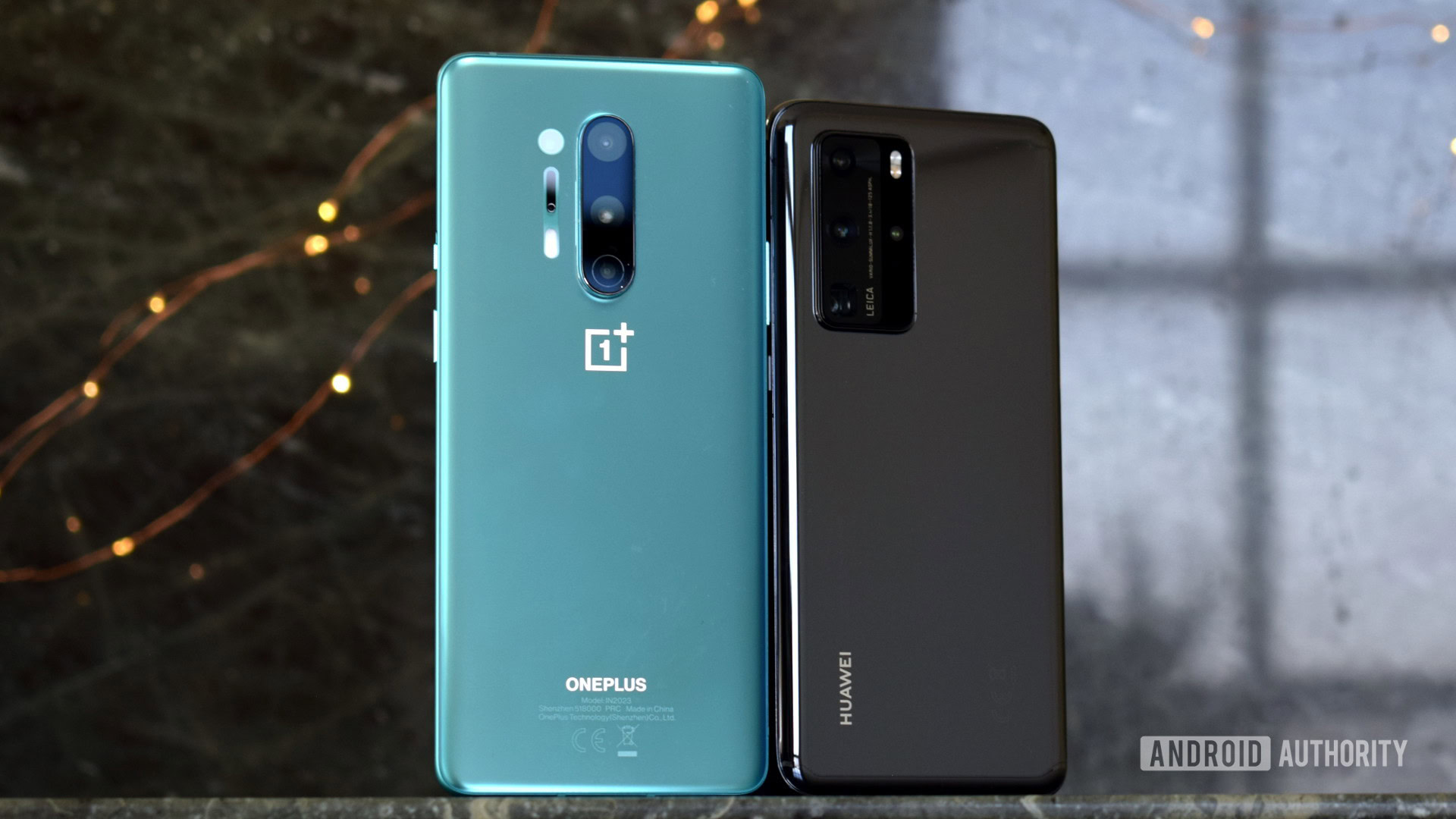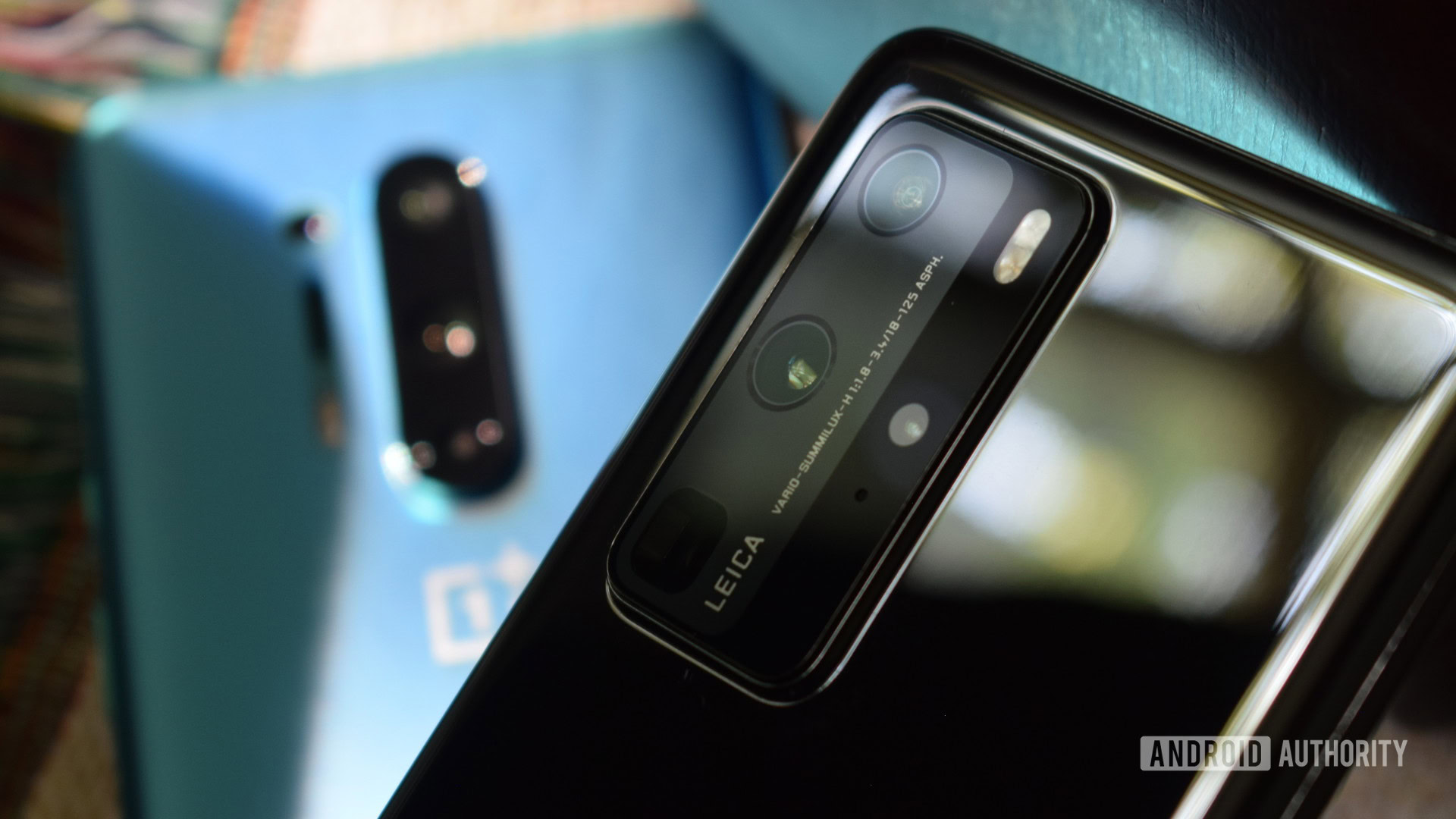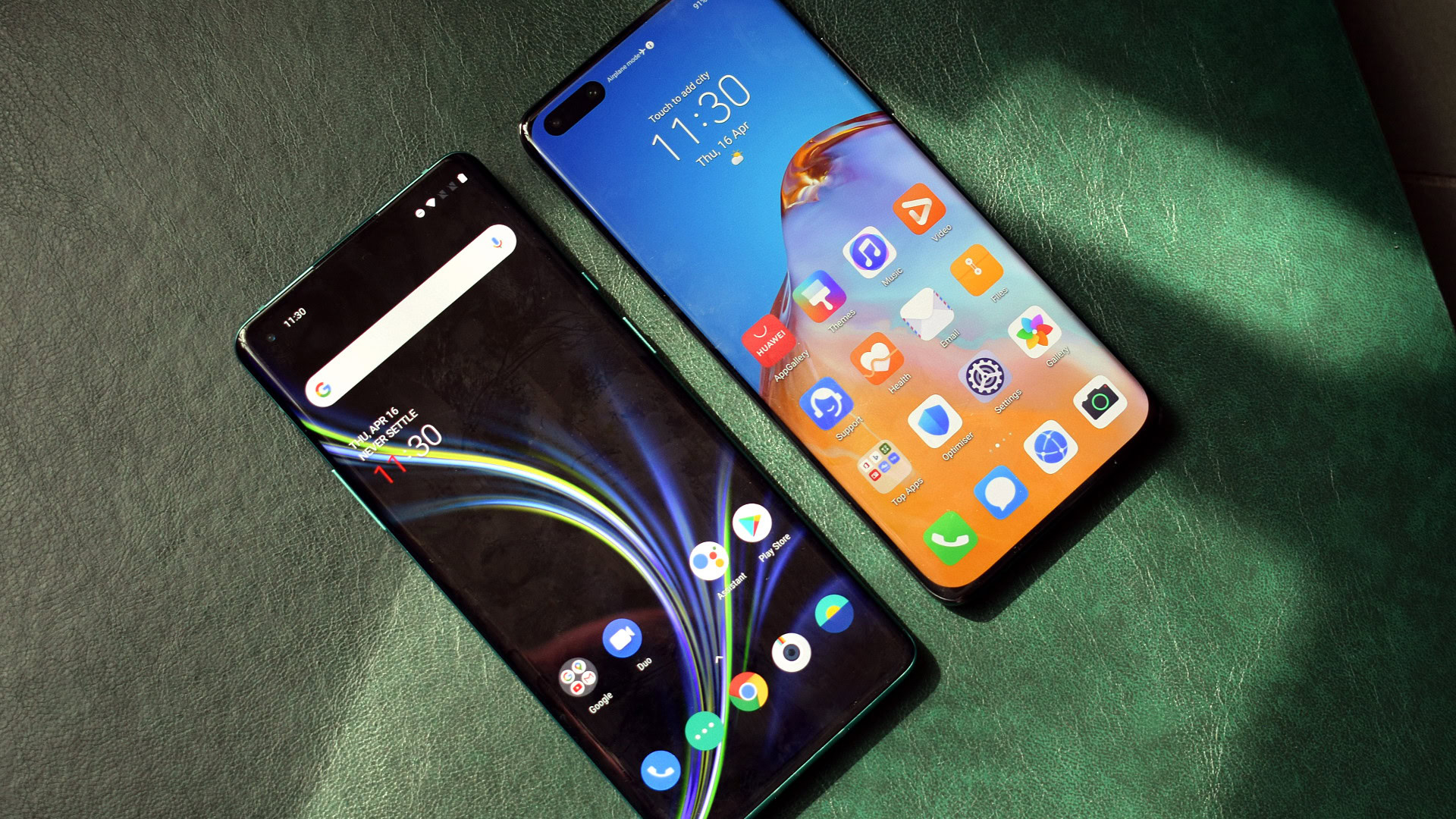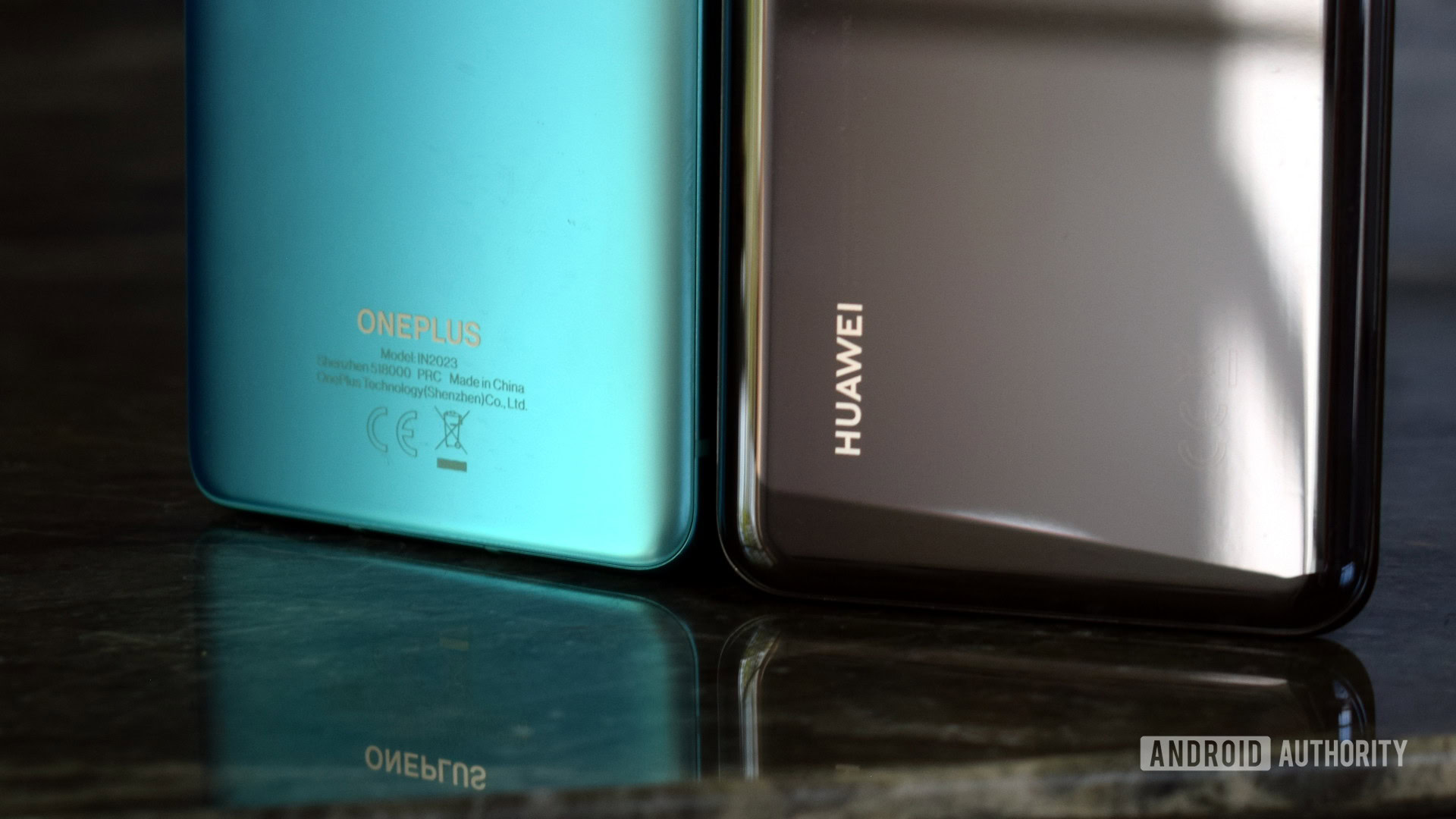Affiliate links on Android Authority may earn us a commission. Learn more.
OnePlus 8 Pro vs HUAWEI P40 Pro: The best of China
Published onJuly 22, 2021

2020 was a year of important smartphone releases, few more so than the OnePlus 8 Pro and the HUAWEI P40 Pro. For OnePlus, the company made a valiant push into the flagship tier, with a higher price tag to match. For HUAWEI, the P40 Pro represented its second global flagship launch without Google services and the first since its status as one of the world’s largest manufacturers came into question.
The HUAWEI P40 Pro and the OnePlus 8 Pro were priced around $999 at launch, although HUAWEI’s offering can set you back up to £200 more in the UK. Despite its price increase, the OnePlus 8 Pro is still a competitive deal. Either way, you’ll get a full suite of high-end features and a top-notch camera experience to justify the price.
Which phone offers the best flagship experience? Find out in our OnePlus 8 Pro vs HUAWEI P40 Pro face-off!
OnePlus 8 Pro vs HUAWEI P40 Pro: Specs at a glance
| OnePlus 8 Pro | HUAWEI P40 Pro | |
|---|---|---|
Display | OnePlus 8 Pro 6.78-inch AMOLED 3,168 x 1,440 (19.8:9) 120Hz refresh rate In-display fingerprint sensor 3D Corning Gorilla Glass | HUAWEI P40 Pro 6.58-inch OLED 2,640 x 1,200 (19.8:9) 90Hz refresh rate In-display fingerprint sensor |
Processor | OnePlus 8 Pro Qualcomm Snapdragon 865 | HUAWEI P40 Pro HiSilicon Kirin 990 |
RAM | OnePlus 8 Pro 8GB / 12GB LPDDR5 | HUAWEI P40 Pro 8GB LPDDR4X |
Storage | OnePlus 8 Pro 128GB / 256GB UFS 3.0 | HUAWEI P40 Pro 128GB / 256GB / 512GB UFS 3.0 |
Cameras | OnePlus 8 Pro Rear: 48MP, f/1.78, 1.12µm, OIS, EIS 8MP 3x telephoto, f/2.44, 1.0µm, OIS 48MP ultrawide, f/2.2, 119.7° 5MP color filter, f/2.4 Front: 16MP, f/2.45, 1.0µm, EIS, fixed focus | HUAWEI P40 Pro Rear: 50MP (RYYB), f/1.9, OIS 40MP f/1.8 ultra-wide 12MP f/3.4 5x periscope 3D ToF depth sensor Front: 32MP IR sensor |
Battery | OnePlus 8 Pro 4,510mAh Warp Charge 30T (5V/6A) Warp Charge 30 Wireless | HUAWEI P40 Pro 4,200mAh 40W SuperCharge 27W SuperCharge Wireless |
IP Rating | OnePlus 8 Pro IP68 | HUAWEI P40 Pro IP68 |
Software | OnePlus 8 Pro Oxygen OS Android 10 | HUAWEI P40 Pro EMUI 10.1 Android 10 |
Dimensions and weight | OnePlus 8 Pro 165.3 x 74.35 x 8.5mm 199g | HUAWEI P40 Pro 158.2 x 72.6 x 9 mm 209g |
Design
Let’s jump right into the design. Both are a little chunkier than your typical handset, but it’s the HUAWEI P40 Pro that’s the thicker and heavier of the two. The OnePlus 8 Pro is notably the taller handset, but the two feel quite comparable in terms of overall bulk. The curved edges help keep the OnePlus 8 Pro easy to handle at the expense of the occasional ghost touch irritation. The HUAWEI P40 Pro’s display is similarly curved, but its edges are a tad rounder. Overall, I’m not sure this gels with either design’s preference for swipe gesture navigation. They just feel a bit awkward.
Both phones have a pronounced camera bump, with the P40 Pro sporting the larger camera housing overall. This means that neither phone lies completely flat on the desk, but HUAWEI’s one-sided camera setup makes the phone rock more and leaves it more susceptible to sliding around. It’s a small bugbear but worth bearing in mind if you’re not a fan of cases.
Both designs have their pros and cons.
The fronts of the phones also look quite different. HUAWEI’s display cutout is far more noticeable and distracting but does house an additional depth sensor. HUAWEI’s bezels aren’t quite as thin as the advertisements make out, either. The OnePlus 8 Pro features a dedicated silent toggle button above the power and positions the volume rocker on the left-hand side. The HUAWEI P40 Pro sticks with a more familiar right-sided power and volume rocker combo. On the bottom, the USB-C, speaker grille, and SIM tray are set up the same. It’s business as usual.
Overall, both designs have their pros and cons. The HUAWEI P40 Pro looks a tad more the part of an expensive 2020 flagship, but it’s undeniably chunky and quite heavy for a phone. OnePlus’ latest design looks a little more 2019, but it feels pretty great to use despite its huge size.
Display
Both handsets sport high refresh rates out of the box; 90Hz for the HUAWEI P40 Pro and 120Hz for the OnePlus 8 Pro. Both models look silky smooth and obtain all-day battery life by scaling some apps down to 60Hz, although OnePlus targets 120Hz for most app UIs. It’s hard to tell just how aggressive this scaling is, but HUAWEI also tweaks resolution on the fly suggesting a more aggressive power-saving profile.
OnePlus grabs an early lead in this regard by offering a higher refresh rate. The OnePlus 8 Pro display scores really well in other metrics, providing superb color accuracy, gamma, and white balance. It’s this year’s display to beat.
Performance
General performance-wise, the OnePlus 8 Pro and its Qualcomm Snapdragon 865 come out comfortably ahead of the HUAWEI P40 Pro’s Kirin 990 5G. The use of newer Arm Cortex-A77 cores gives the Snapdragon 865 a slight lead on the CPU side, and LPDDR5 vs LPDDR4X helps produce a better system score.
The biggest difference between the two, though, is in the GPU department. Qualcomm’s Adreno 650 bests the older Arm Mali-G76 MP16 comfortably. That said, the HUAWEI P40 Pro’s graphics performance is competitive with last year’s Snapdragon 855 handsets. So it’s certainly not a slouch at gaming, although finding the titles you want to play is a whole other matter (more on that later).
Read more: How do the Qualcomm Snapdragon 865, Kirin 990, and Exynos 990 compare?
Despite the benchmark differentials, you certainly won’t encounter any problems with day-to-day apps on the HUAWEI P40 Pro. It’s important to keep in mind that a benchmark lead doesn’t necessarily translate to a completely different experience for most apps. However, if you want to play the most demanding Android games with the highest frame rates, the OnePlus 8 Pro and its Snapdragon 865 is the clear choice.
Camera

You can’t talk about smartphone cameras without mentioning HUAWEI. The company has built its mobile reputation on virtually this department alone. The OnePlus 8 Pro will be a real winner if it can impress here.
OnePlus scores an early win with its color processing and white balance. It’s highly consistent in this regard, providing good tones without too much oversaturation. The HUAWEI P40 Pro is far more conservative with its colors and has the occasional balance issue, either overexposing or producing a red hue.
However, the HUAWEI P40 Pro scores big points for detail. Its large main sensor requires very little post-processing, ensuring smooth details and minimal noise. OnePlus opts for a heavy sharpening pass to enhance details, but it leaves crops looking a little artificial.
Although the HUAWEI P40 Pro has the larger main image sensor (1/1.28-inch versus 1/1.4-inch), the two are quite comparable in low light. Both phones capture with minimal noise and good details, and I’m tempted to give the nod to OnePlus for its better color balance.
However, taking the cameras into very low light scenarios causes some issues. HUAWEI’s images come out heavily processed, with harsh edges and high ISO noise in dark areas. Night mode cleans this up a tad, but the HDR effect is too strong. OnePlus’ Nightscape looks more natural, but the camera sometimes suffers from overly warm tones.
The two handsets also sport wide-angle cameras. The OnePlus 8 Pro offers a wider field of view, allowing you to fit more into the scene, which is the whole point of a wide-angle camera. However, the level of detail isn’t great for a 48MP sensor, with distortion apparent around image edges. The camera’s focus isn’t great for longer-range detail either.
Huawei’s 40MP wide-angle sensor captures a lot more detail and dynamic range while also controlling edge distortion a lot better. But the narrower field of view makes it a little less versatile.
Finally, onto the zoom cameras. On paper, the HUAWEI P40 Pro’s 5x periscope camera sounds the more impressive, and it does hold up best at 5x and 10x. However, HUAWEI’s hybrid zoom technology doesn’t look so good at short ranges. The OnePlus 8 Pro is oddly poor at 2x but offers comparable if not better images than the P40 Pro between 3x and 5x. Although again, the company’s sharpening algorithm looks too heavy when cropping in.
The two phones also each have a fourth camera. The OnePlus 8 Pro sports a color filter camera for an interesting photochromic effect — you’ll probably use it once and forget about it. The time-of-flight sensor in the HUAWEI P40 Pro helps with bokeh edge detection and does an excellent job at ensuring smooth-looking blur. HUAWEI’s fourth camera is definitely the more useful addition.
On balance, the HUAWEI P40 Pro offers the best balance of quality and versatility. However, the OnePlus 8 Pro has certainly closed the gap in terms of the main camera and even zoom quality. For a closer look at these two camera packages and how they compare to the Samsung Galaxy S20 Plus, check out our full shootout below:
Odds and extras
If all that wasn’t enough, these phones sport a range of other high-end smartphone features. You’ll find in-display fingerprint scanners on both handsets, which work well enough for device security. Both also support facial recognition, but only HUAWEI provides additional front-facing infra-red hardware for bolstered security.
OnePlus 8 Pro vs HUAWEI P40 Pro: Which phone is the better buy?
These two manufacturers have long boasted fast charging capabilities, and both phones enhance this with fast wireless charging. They’re pretty comparable in terms of speeds, with the OnePlus 8 Pro boasting 30W against the HUAWEI P40 Pro’s 27W. Unfortunately, you’ll need to buy proprietary charging docks for either phone to make use of these fast speeds.
The handsets support sub-6Ghz 5G networks as well. While probably not applicable to most customers just yet, these phones are futureproofed if you’re contemplating moving to a faster 5G network. Finally, OnePlus includes IP68 water and dust resistance on the 8 Pro — a first for the Shenzhen firm. This matches the standard you’ll find on the HUAWEI P40 Pro, making both quite durable.
EMUI vs Oxygen OS

OnePlus’ Oxygen OS and Huawei’s EMUI are very different approaches to Android. HUAWEI opts for a more colorful and playful interface, while Oxygen OS is sleeker and more professional-looking. This aesthetic carries over to the attention to detail too. EMUI’s setting menu has improved, but it’s still a labyrinth compared to Oxygen OS’s simplicity and ease of use. OnePlus also offers a powerful customization engine, parallel apps, app locker, and more. EMUI has its charms, including a powerful dark mode, App Twin, and its own downloadable and customizable themes.
But by far, the biggest difference for most consumers is the lack of Google services on the HUAWEI P40 Pro. Suffice to say, the lack of GMS and so-so app support in the App Gallery will be a major drawback for most users, and there’s a fair bit more to go before HUAWEI has a suitable solution in place. More tech-savvy Android users might be able to live with the workarounds if they really want the P40 Pro, but it’s a big hurdle to clear.
Check out our article below for more on the current pros and cons of HUAWEI’s App Gallery:
OnePlus 8 Pro vs HUAWEI P40 Pro: The verdict

The OnePlus 8 Pro and HUAWEI P40 Pro offer solid hardware packages where the differences really come down to fine margins. With several similarities, design, software, and camera capabilities are the biggest differentiators. OnePlus offers slick software, an excellent 120Hz display, bleeding-edge performance, and a whole host of flagship extras. For a gargantuan phone, I also quite like the way it handles compared to the weighty P40 Pro. It’s also a little bit cheaper too, giving it an edge for value for money.
It all comes down to fine margins... except for the software.
The HUAWEI P40 Pro really is a photographer’s smartphone. The app situation alone makes it a tough sell in many markets and especially to those embedded in Google’s ecosystem. It’s tricky to justify the P40 Pro on its camera package alone, especially when its rivals are closing the quality gap. Those who want what is arguably the most versatile camera phone may just about be able to justify the leap. For everyone else, I’d recommend you play it safe and opt for the more affordable OnePlus 8 Pro or even last year’s HUAWEI P30 Pro.